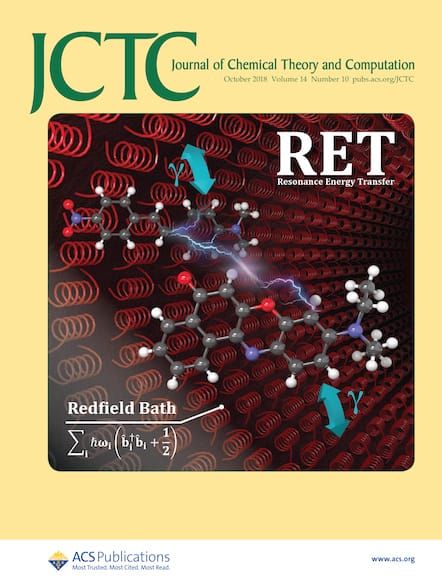Benchmarking Alchemical Relative Binding Free Energy Calculations for Nucleotide Binding to Multimeric ATPases.
IF 5.5
1区 化学
Q2 CHEMISTRY, PHYSICAL
引用次数: 0
Abstract
Multimeric ATPases generally bind nucleotides at intersubunit interfaces, where cooperative or allosteric interactions complicate experimental measurement of binding affinities. Here, we present a large-scale benchmarking study of alchemical relative binding free energy (RBFE) calculations using fixed-charge force fields across six classes of oligomeric ATPases: F1-ATPase, MalK, MCM, Rho, FtsK, and gp16. While previous absolute or relative binding free energy studies have largely focused on monomeric or single-site ATPases, this work extends RBFE calculations to 55 interfacial binding sites in multimeric ATPases, providing insight into the successes and limitations of alchemical free energy methods in complex, cooperative systems. RBFE simulations were conducted both in the presence and absence of the central substrate (DNA or RNA) to assess its impact on nucleotide-binding free energies. The highly charged and conformationally flexible nature of nucleotide ligands necessitated extensive sampling (>20 ns per alchemical window) to account for slow relaxation associated with long-range electrostatic interactions. Our RBFE results reproduced experimentally observed binding preferences for 91% of the sites in F1-ATPase, MalK, and MCM ATPases, which exhibited low global and local structural deviations during simulations across alchemical windows. In contrast, only 60% agreement was observed for Rho, FtsK, and gp16─systems with greater structural variability. This study not only highlights the predictive potential of alchemical free energy methods for nucleotide binding in protein complexes but also systematically identifies key sources of RBFE error, including structural fidelity, protein flexibility, ligand pose instability, and disruption of critical binding interactions during alchemical transformations. Furthermore, AlphaFold3 (AF3) was used to model a gp16 structure with higher structural stability than the available cryo-EM structure, and RBFE results indicate that the two models may correspond to distinct functional states (nucleotide-binding preferences) during the substrate translocation cycle.核苷酸与多聚ATPases结合的基准炼金术相对结合自由能计算。
多聚三磷酸腺苷酶通常在亚基间界面结合核苷酸,其中合作或变构相互作用使结合亲和力的实验测量复杂化。在这里,我们提出了一个大规模的基准研究炼金术相对结合自由能(RBFE)计算使用固定电荷力场在六类低聚atpase: F1-ATPase, MalK, MCM, Rho, FtsK和gp16。虽然以前的绝对或相对结合自由能研究主要集中在单体或单位点atp酶上,但这项工作将RBFE计算扩展到多聚ATPases的55个界面结合位点,从而深入了解炼金术自由能方法在复杂合作系统中的成功和局限性。RBFE模拟在中心底物(DNA或RNA)存在和不存在的情况下进行,以评估其对核苷酸结合自由能的影响。核苷酸配体的高电荷和构象灵活的性质需要广泛的采样(每个炼金术窗口bbb20 ns)来解释与远程静电相互作用相关的缓慢弛豫。我们的RBFE结果再现了实验观察到的f1 - atp酶、MalK和MCM atp酶中91%的位点的结合偏好,在模拟炼金术窗口时表现出较低的全局和局部结构偏差。相比之下,结构变异性较大的Rho、FtsK和gp16─系统只有60%的一致性。这项研究不仅强调了炼金术自由能方法对核苷酸在蛋白质复合物中结合的预测潜力,而且系统地确定了RBFE误差的关键来源,包括结构保真度、蛋白质柔韧性、配体姿态不稳定性以及炼金术转化过程中关键结合相互作用的破坏。此外,利用AlphaFold3 (AF3)构建的gp16结构比现有的冷冻电镜结构具有更高的结构稳定性,RBFE结果表明,在底物易位周期中,这两种模型可能对应不同的功能状态(核苷酸结合偏好)。
本文章由计算机程序翻译,如有差异,请以英文原文为准。
求助全文
约1分钟内获得全文
求助全文
来源期刊

Journal of Chemical Theory and Computation
化学-物理:原子、分子和化学物理
CiteScore
9.90
自引率
16.40%
发文量
568
审稿时长
1 months
期刊介绍:
The Journal of Chemical Theory and Computation invites new and original contributions with the understanding that, if accepted, they will not be published elsewhere. Papers reporting new theories, methodology, and/or important applications in quantum electronic structure, molecular dynamics, and statistical mechanics are appropriate for submission to this Journal. Specific topics include advances in or applications of ab initio quantum mechanics, density functional theory, design and properties of new materials, surface science, Monte Carlo simulations, solvation models, QM/MM calculations, biomolecular structure prediction, and molecular dynamics in the broadest sense including gas-phase dynamics, ab initio dynamics, biomolecular dynamics, and protein folding. The Journal does not consider papers that are straightforward applications of known methods including DFT and molecular dynamics. The Journal favors submissions that include advances in theory or methodology with applications to compelling problems.
 求助内容:
求助内容: 应助结果提醒方式:
应助结果提醒方式:


